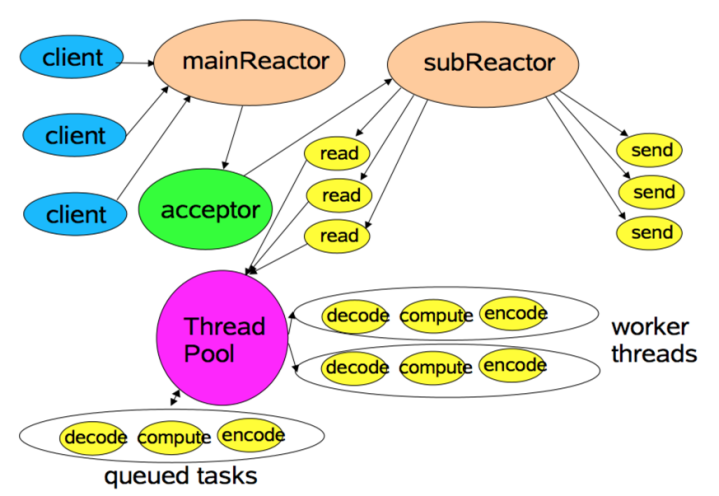Netty是一个高性能、异步事件驱动的网路通信框架 ,由于精力有限,本人并没有对其源 码做了特别细致的研究。如果下面的内容有错误或不严谨的地方,也请大家指正和谅解。
Netty的线程模型是Reactor主从模型的变种,去掉了线程池,使用串行化实现。
Reactor主从模型如下图所示

(mainReactor负责监听server socket,accept新连接;并将建立的socket分派给subReactor。
subReactor负责多路分离已连接的socket,读写网络数据,对业务处理功能,其扔给worker线程池完成。通常,subReactor个数上可与CPU个数等同)
Netty中Reactor模式的参与者主要有下面一些组件:
Selector
EventLoopGroup/EventLoop
ChannelPipeline
Selector即为NIO中提供的多路复用器,这里不再阐述。
EventLoopGroup/EventLoop
EventLoopGroup是一组EventLoop的抽象,在Netty服务器编程中我们需要BossEventLoopGroup和WorkerEventLoopGroup两个EventLoopGroup来进行工作。通常一个服务端口即一个ServerSocketChannel对应一个Selector和一个EventLoop线程,也就是说BossEventLoopGroup的线程数参数为1。BossEventLoop主要负责接收客户端的连接并
将SocketChannel交给WorkerEventLoopGroup来进行处理。
ChannelPipeline
ChannelPipeline在Reactor模式中担任请求处理器的角色,通过调用相关的handler进行相对应的处理。
以下是第一个入门程序
import io.netty.bootstrap.ServerBootstrap;
import io.netty.channel.ChannelFuture;
import io.netty.channel.ChannelInitializer;
import io.netty.channel.ChannelOption;
import io.netty.channel.EventLoopGroup;
import io.netty.channel.nio.NioEventLoopGroup;
import io.netty.channel.socket.SocketChannel;
import io.netty.channel.socket.nio.NioServerSocketChannel;
public class Server {
public static void main(String[] args) throws Exception {
// 1 第一个线程组 是用于接收Client端连接的
EventLoopGroup bossGroup = new NioEventLoopGroup();
// 2 第二个线程组 是用于实际的业务处理操作的
EventLoopGroup workerGroup = new NioEventLoopGroup();
// 3 创建一个辅助类Bootstrap,就是对我们的Server进行一系列的配置
ServerBootstrap bbootStarp = new ServerBootstrap();
// 把俩个工作线程组加入进来
bbootStarp.group(bossGroup, workerGroup)
// 指定使用NioServerSocketChannel这种类型的通道
.channel(NioServerSocketChannel.class)
// 一定要使用 childHandler 去绑定具体的 事件处理器
.childHandler(new ChannelInitializer<SocketChannel>() {
@Override
protected void initChannel(SocketChannel sc) throws Exception {
sc.pipeline().addLast(new ServerHandler());
}
});
// 绑定指定的端口 进行监听
ChannelFuture channelFuture = bbootStarp.bind(8765).sync();
// 让其不关闭
channelFuture.channel().closeFuture().sync();
bossGroup.shutdownGracefully();
workerGroup.shutdownGracefully();
}
}
import io.netty.buffer.ByteBuf;
import io.netty.buffer.Unpooled;
import io.netty.channel.ChannelFutureListener;
import io.netty.channel.ChannelHandlerContext;
import io.netty.channel.ChannelInboundHandlerAdapter;
import io.netty.util.ReferenceCountUtil;
public class ServerHandler extends ChannelInboundHandlerAdapter {
//处理客户端发送过来的数据
@Override
public void channelRead(ChannelHandlerContext ctx, Object msg) throws Exception {
try {
ByteBuf byteBuffer = (ByteBuf) msg;
byte[] data = new byte[byteBuffer.readableBytes()];
byteBuffer.readBytes(data);
String sData = new String(data,"utf-8");
System.out.println("server "+sData);
//写操作完成以后就断开连接
ctx.writeAndFlush(Unpooled.copiedBuffer("888".getBytes())).addListener(ChannelFutureListener.CLOSE);
} finally {
ReferenceCountUtil.release(msg);
}
}
@Override
public void exceptionCaught(ChannelHandlerContext ctx, Throwable cause) throws Exception {
cause.printStackTrace();
ctx.close();
}
}
import io.netty.bootstrap.Bootstrap;
import io.netty.buffer.Unpooled;
import io.netty.channel.ChannelFuture;
import io.netty.channel.ChannelInitializer;
import io.netty.channel.EventLoopGroup;
import io.netty.channel.nio.NioEventLoopGroup;
import io.netty.channel.socket.SocketChannel;
import io.netty.channel.socket.nio.NioSocketChannel;
public class Client {
public static void main(String[] args) throws Exception {
EventLoopGroup workgroup = new NioEventLoopGroup();
Bootstrap boot = new Bootstrap();
boot.group(workgroup)
.channel(NioSocketChannel.class)
.handler(new ChannelInitializer<SocketChannel>() {
@Override
protected void initChannel(SocketChannel sc) throws Exception {
sc.pipeline().addLast(new ClientHandler());
}
});
ChannelFuture channelFuture = boot.connect("127.0.0.1", 8765).sync();
//buf
channelFuture.channel().writeAndFlush(Unpooled.copiedBuffer("777".getBytes()));
channelFuture.channel().closeFuture().sync();
workgroup.shutdownGracefully();
}
}
import io.netty.buffer.ByteBuf;
import io.netty.channel.ChannelHandlerContext;
import io.netty.channel.ChannelInboundHandlerAdapter;
import io.netty.util.ReferenceCountUtil;
public class ClientHandler extends ChannelInboundHandlerAdapter {
@Override
public void channelRead(ChannelHandlerContext ctx, Object msg) throws Exception {
try {
// do something
ByteBuf buf = (ByteBuf) msg;
byte[] data = new byte[buf.readableBytes()];
buf.readBytes(data);
String request = new String(data, "utf-8");
System.out.println("Client: " + request);
} finally {
// 如果没有调用write或者writeAndFlush 需要手动释放msg
ReferenceCountUtil.release(msg);
}
}
@Override
public void exceptionCaught(ChannelHandlerContext ctx, Throwable cause) throws Exception {
cause.printStackTrace();
ctx.close();
}
}
可以看到,server 和client的创建连接或者发送请求的代码的都是相对固定的,实际开发中 我们专注写handler 就好。